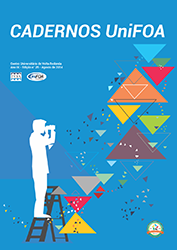Soil water saturation monitoring system to prevent gravitational mass movements.
DOI:
https://doi.org/10.47385/cadunifoa.v19.n54.5029Keywords:
Mass movement. Saturation. Soil Monitoring. Microcontroller. Arduino.Abstract
The purpose of this work is to develop a system that performs soil data acquisition, in order to previously identify the possibility of the occurrence of gravitational mass movements by monitoring stations for geotechnical and environmental accidents. The system aims to anticipate the occurrence of gravitational mass movements related to water saturation in the soil and subsoil to mitigate human and material damage, as well as for environmental monitoring of geological risk areas. For this, a prototype was developed, based on Arduino control to acquire information on soil moisture level and slope. With the prototype developed, the next step was to carry out tests in the laboratory to prove the effectiveness of the designed system. The prototype was assembled under the supervision of a competent professor in the area of soil mechanics, with the aim of carrying out an experiment capable of simulating the operation of the device on a real slope.
Downloads
References
ARDUINO®. ARDUINO.CC. Site que se ocupa em disseminar e entregar conhecimentos acerca de tecnologias aplicáveis ao Arduino, como banco de dados de bibliotecas; informações sobre funções etc. Disponível em: < https://docs.arduino.cc/learn/>. Acessado em 23 de junho de 2023.
CANAL FUNBOTS. Teste de alcance de um LoRa | Módulo LoRa com Arduino muito simples!. YouTube, 2021. Disponível em: < https://www.youtube.com/watch?v=mafyHPyFKoE>. Acessado em: 15 de agosto de 2023.
CEMADEN. Centro Nacional de Monitoramento e Alertas de Desastres Naturais – Site Oficial. São José dos Campos: CEMADEN / MCTI. Disponível em: . Acesso em: 13 de março de 2024.
COELHO NETTO, A. L. Hidrologia da encosta na interface com a Geomorfologia. In: Geomorfologia: uma atualização de bases e conceitos. CUNHA, S. B. da & GUERRA, A. J. T. (orgs.) 6ª Ed. Rio de Janeiro: Editora Bertrand Brasil, 2005. 472p.
CRISPIM, F.A, et al. Compactação de solos em laboratório: efeito do diâmetro e do número de camadas do corpo de prova. Scielo Brasil, 2015. Disponível em: < https://www.scielo.br/j/rarv/a/XY5Gd5BWPzsFPWXmpDGqdbm/?lang=pt#>. Acessado em: 02 de outubro de 2023.
CRISPIM, F.A. Influência de variáveis de compactação na estrutura dos solos: caracterizações geotécnica, química, mineralógica e microestrutural. 2010. 125f. Tese (Doutorado em Engenharia Civil) - Universidade Federal de Viçosa, Viçosa, MG, 2010.
EMBRAPA. Manual de Métodos de Análise de Solo. Disponível em: . Acessado em 10 de julho de 2023.
FORMOSO, M. T. Desenvolvimento de um Inclinômetro para monitorar o comportamento de Taludes Instáveis de Solos. Disponível em: <https://www.lume.ufrgs.br/bitstream/handle/10183/119377/000295172.pdf?sequence=1&isAllowed=y >. Acessado em 15 de setembro de 2023.
GUERRA, A. J. T. & LOUREIRO, H. A. S. Erosão em áreas tropicais. Editora Interciência, Rio de Janeiro, 2023. 270p.
GUIMARÃES, Fábio. Acelerômetro MPU6050 com Arduino. Mundo Projetado, 2018. Disponível em: < https://mundoprojetado.com.br/acelerometro-mpu6050-arduino/>. Acessado em: 15 de setembro de 2023.
HIGHLAND, L.M.; BOBROWSKY, P. The landslide handbook – A guide to understanding landslides (tradução de Rogério, P.R. e Aumond, J.J.). Reston, Virginia: U.S. Geological Survey, 2008, Circular1325, 129p. Disponível em: https://www.gfdrr.org/sites/default/files/publication/Deslizamentos_M5DS_0.pdf. Acesso em: 27 de fevereiro de 2024.
MACEDO, E. S. de & SANDRE, L. H. Mortes por deslizamentos no Brasil: 1998 a 2022. Instituto de Pesquisas Tecnológica de São Paulo. 2022. Disponível em: https://ipt.br/2023/03/29/mortes-por-deslizamentos-no-brasil-1988-a-2022/. Acesso em 19 de fevereiro de 2023.
MACIEL FILHO, C.L. Introdução à Geologia de Engenharia (4ª Ed.). Santa Maria: UFSM, 2011, p 369-388.
OLIVEIRA, A. M. S.; BRITO, S. N. A. Geologia de Engenharia. São Paulo: ABGE, 1998, p 243-269.
MARONGON, M. Tensão nos Solos. Disponível em: <https://pt.scribd.com/document/406131429/MARANGON-2018-Capítulo-02-Tensoes-Nos-Solos-2018>. Acessado em 10 de julho de 2023.
MARONGON, M. Tópicos em Geotecnia e Obras de Terra. Unidade 04 Estabilidade de taludes. Disponível em: <https://pt.scribd.com/document/332453287/Apostila-Estabilidade-de-Taludes-Marangon>. Acessado em 15 de agosto de 2023.
SHARLENE. WT901 Atitude Angle Sensor SPECIFICATIONS. V4.0. Publicado em: 10 de agosto de 2018, 50 pag.
THOMSEN, Adilson. Monitore sua planta usando Arduino. Maker Hero, 2016. Disponível em: <https://www.makerhero.com/blog/monitore-sua-planta-usando-arduino/>. Acessado em 20 de abril de 2023.
ZAHID, Yousef. Seleção de pinos para I2C em um Arduino Uno. DelftStack, 2021. Disponível em: <https://www.delftstack.com/pt/howto/arduino/i2c-pin-selection-for-arduino-uno/>. Acessado em:
Downloads
Published
How to Cite
Issue
Section
License
Copyright (c) 2024 Cadernos UniFOA

This work is licensed under a Creative Commons Attribution-NonCommercial-ShareAlike 4.0 International License.
Declaração de Transferência de Direitos Autorais - Cadernos UniFOA como autor(es) do artigo abaixo intitulado, declaro(amos) que em caso de aceitação do artigo por parte da Revista Cadernos UniFOA, concordo(amos) que os direitos autorais e ele referentes se tornarão propriedade exclusiva desta revista, vedada qualquer produção, total ou parcial, em qualquer outra parte ou meio de divulgação, impressa ou eletrônica, sem que a prévia e necessária autorização seja solicitada e, se obtida, farei(emos) constar o agradecimento à Revista Cadernos UniFOA, e os créditos correspondentes. Declaro(emos) também que este artigo é original na sua forma e conteúdo, não tendo sido publicado em outro periódico, completo ou em parte, e certifico(amos) que não se encontra sob análise em qualquer outro veículo de comunicação científica.
O AUTOR desde já está ciente e de acordo que:
- A obra não poderá ser comercializada e sua contribuição não gerará ônus para a FOA/UniFOA;
- A obra será disponibilizada em formato digital no sítio eletrônico do UniFOA para pesquisas e downloads de forma gratuita;
- Todo o conteúdo é de total responsabilidade dos autores na sua forma e originalidade;
- Todas as imagens utilizadas (fotos, ilustrações, vetores e etc.) devem possuir autorização para uso;
- Que a obra não se encontra sob a análise em qualquer outro veículo de comunicação científica, caso contrário o Autor deverá justificar a submissão à Editora da FOA, que analisará o pedido, podendo ser autorizado ou não.
O AUTOR está ciente e de acordo que tem por obrigação solicitar a autorização expressa dos coautores da obra/artigo, bem como dos professores orientadores antes da submissão do mesmo, se obrigando inclusive a mencioná-los no corpo da obra, sob pena de responder exclusivamente pelos danos causados.










